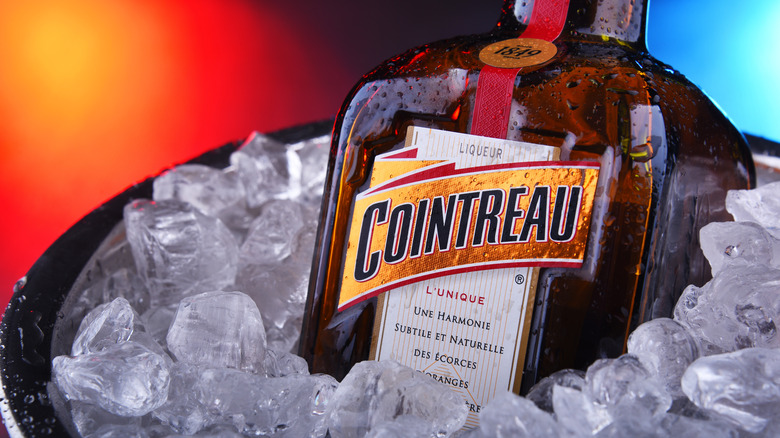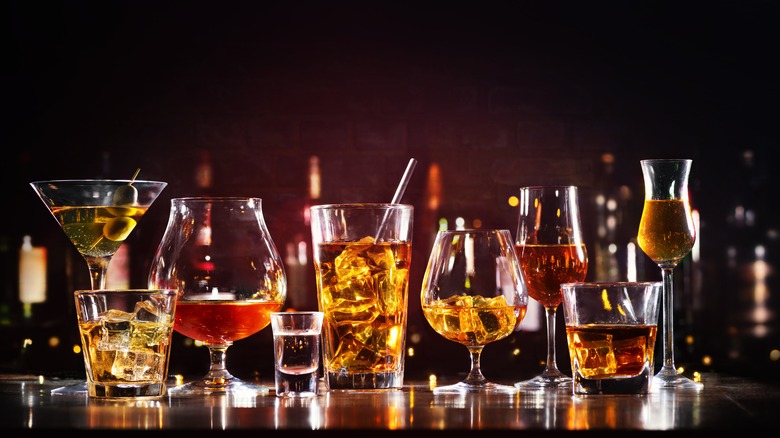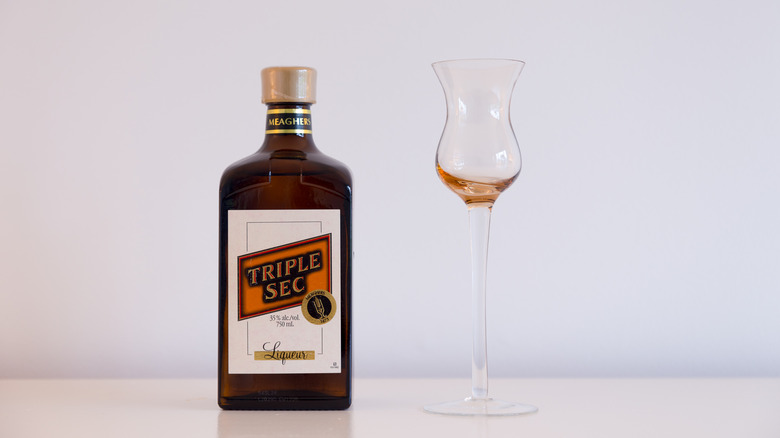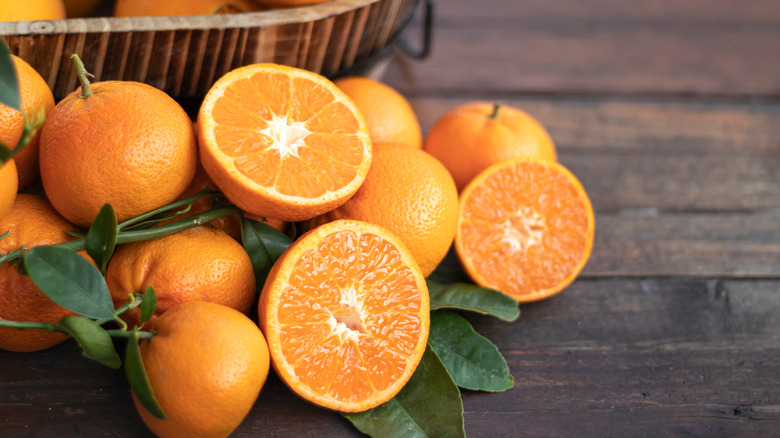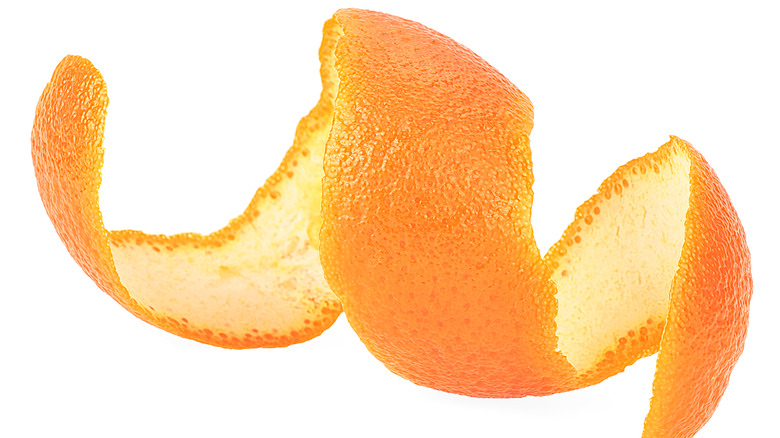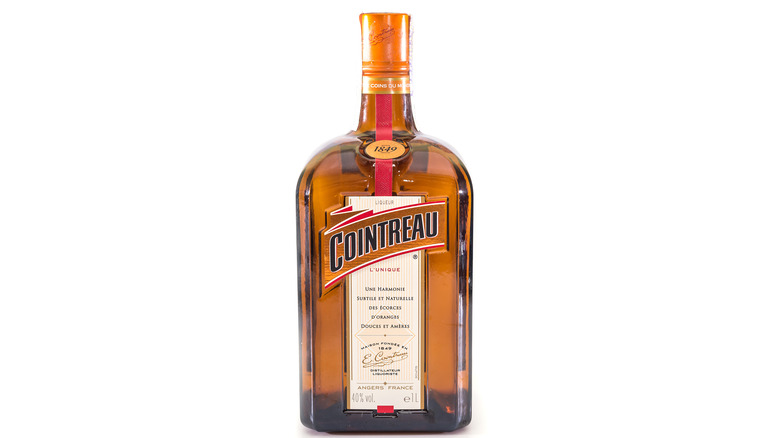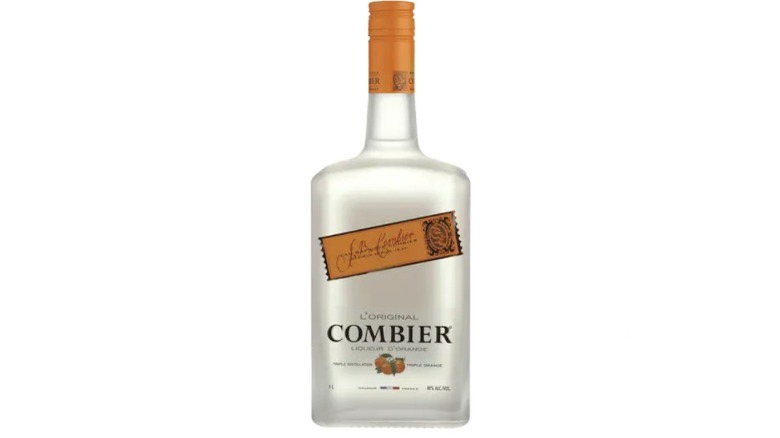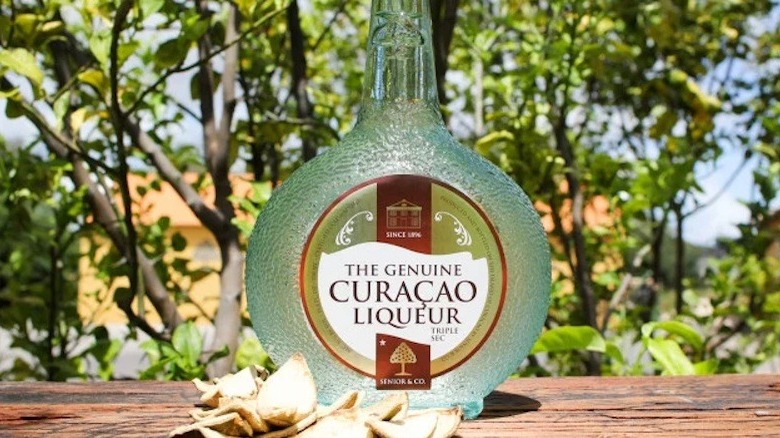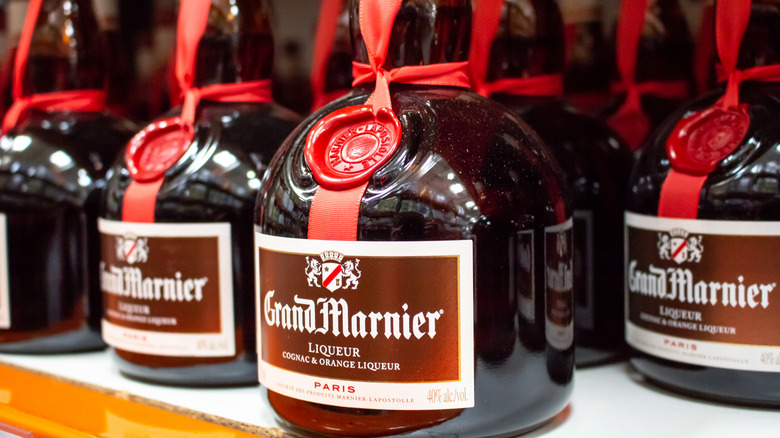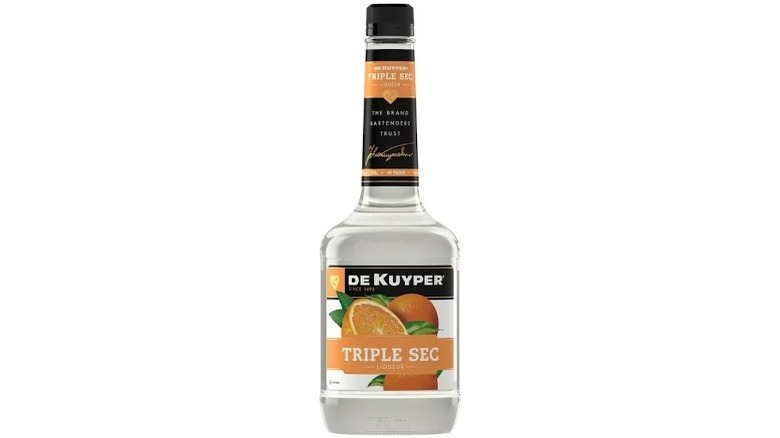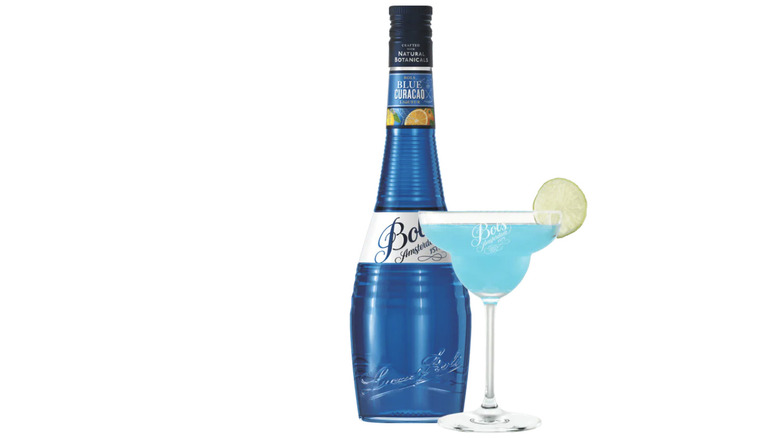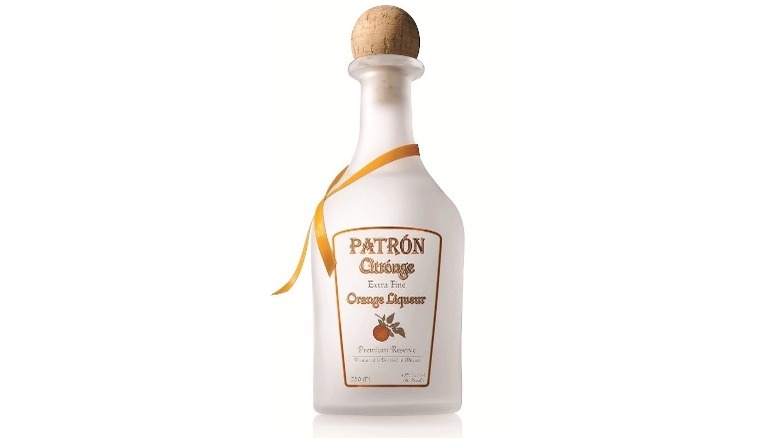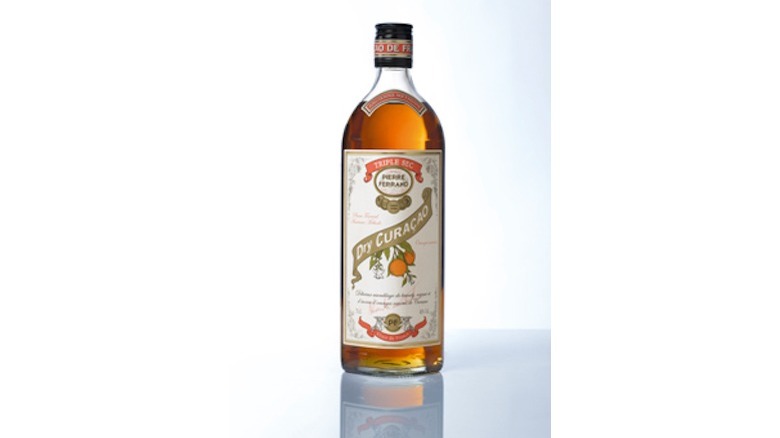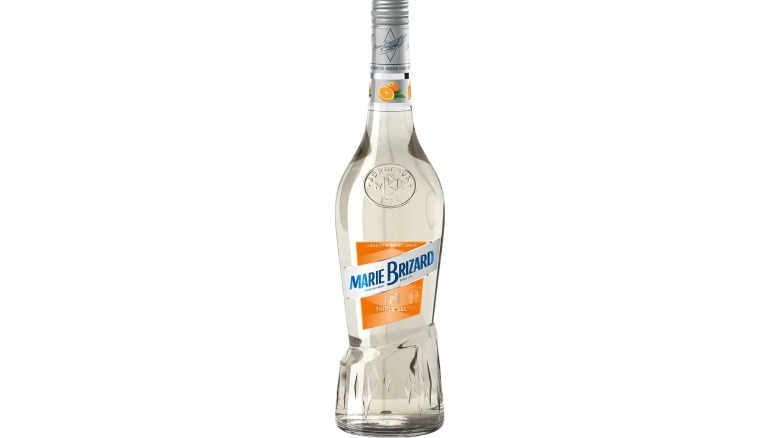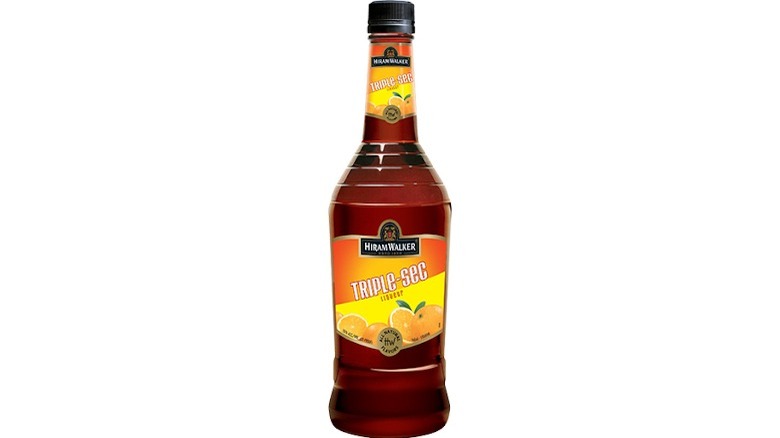A Beginner's Guide To Orange Liqueurs
The world of orange liqueurs is far-reaching. These delicious citrus cordials are made around the world and each brand features its own unique flavor profile. Orange liqueur comes in bottles of all shapes and sizes, and the cordial's colors vary from clear to neon blue. Visit any liquor store, and you will be bombarded with orange liqueurs from all over the world, some of which use terms such as "triple sec" and "curaçao."
With all the options available, it can be hard to know what orange liqueur to use in your cocktail recipe. That's why we created this complete guide for beginners. We will walk you through some terminology and history and take you on a tour of the popular brands. Whether you are pouring a glass to sip on or using it to make one of your favorite orange liqueur-based cocktails, like the cosmopolitan or the margarita, this article will help ensure you reach for the perfect bottle to suit your needs.
Common terminology
A lot of terms get thrown around in the world of alcohol. To help untangle the wires, we are going to start with some basic definitions that are used when talking about orange liqueur. First, liqueurs and cordials are two terms that frequently show up when discussing orange-flavored alcohol. You may be wondering what the difference is, and it is actually an easy answer: There is no difference. The two terms are entirely interchangeable. Both liqueur and cordials are natural spirits — think rum, vodka, and brandy — that are mixed with flavors, such as herbs, spices, and fruits. Note that the term liqueur should not be confused with liquor, which is simply distilled alcohol.
Liqueurs are available in a variety of flavors, including honey, coffee, and orange. They have an alcohol content of between 28 and 32%, according to American Addiction Centers.
History of orange liqueur
Like many things in the food and drink world, the origins of the first orange liqueur are heavily disputed. Orange liqueur first came to prominence in the late 17th century (Senior & Co.). French brand Combier claims to have produced the first triple sec in 1834. Cointreau, another popular French brand, began producing its orange liqueur in 1857, while Grand Marnier began production in 1880. All of these predate the first mention of curaçao.
According to the Atlantic, curaçao began production on its island namesake in 1896. Senior & Co. was also founded the same year and appears to be one of the early market producers of curaçao liqueur. Additionally, Combier began making an orange liqueur in the back of their confectionary shop. While they claim the title of "first triple sec," that does not necessarily mean they were the first to make an orange distilled liqueur. Brand Marie Brizard claims to have made the first French orange liqueur as early as the 1700s.
Everyone wants to be the first. But when it comes to such a general concept as an orange-flavored liqueur, we may never know who actually invented it. Each brand produces its own variation and contributes to a truly intriguing history of orange cordials.
Types of orange liqueur
Curaçao and triple sec are the two terms associated with orange liqueur that you'll most likely encounter at the store. Both of these liqueurs have the same definition per the Alcohol and Tobacco Trade Bureau, which is simply an "orange-flavored liqueur/cordial."
To make matters more confusing, these interchangeable definitions are due to the fact that there are no legal definitions for either term. This is particularly odd for the world of liquor, where authorities seem to create highly specific laws around what is and is not a specific alcoholic beverage. For example, bourbon must be produced in the United States, made from a mash of at least 51% corn, cannot be more than 62.5% alcohol, and must be charred in new oak barrels (via Alcohol and Tobacco Trade Bureau).
The lack of regulation becomes even odder when you consider that alcohol named after places, such as Champagne and Cognac, often must be produced and bottled only in those locations. However, curaçao may come from anywhere.
And what does triple sec mean, anyway? Honestly, no one really knows. Some claim that it translates to triple dry, which refers to the triple distilling process. Others claim it refers to the three types of orange peel used in the recipe (via Difford's Guide).
Some perceived differences
While curaçao and triple sec may not have legal definitions, they do have some subtle differences. Curaçao was created by Dutch traders, and Difford's Guide goes on to mention the drink is named for the island of Curaçao, which was occupied by the Dutch at the time and from where they acquired their oranges to make the liqueur. While the original drink is clear, there is a blue version of the drink known as blue curaçao that became popular in the 20th century.
Triple sec, on the other hand, started as a French liqueur and tends to be a little sweeter than its Dutch cousin. It's usually made with a base spirit of beet sugar (via Difford's Guide).
According to Bevvy.com, triple sec is typically column-distilled, whereas curaçao is commonly pot-distilled. The different distilling methods can account for variations in the color and sweetness of the two liqueurs. But again, it bares mentioning there is no legal or definitive definition between the two. Though these liqueurs started out differently, they are generally interchangeable in recipes. Additionally, some brands, such as Senior & Co., use both titles to avoid confusion.
Cointreau
Although Cointreau was founded in 1849, it did not start producing its famous orange liqueur until 1875 (via Cointreau). The company decided on a bold look for its bottle to help distinguish itself from other orange liqueurs and showcase its unique flavor. The four sides of the bottle were designed to represent the company's goal to reach the four corners of the world, as well as the four ingredients used in the liquor. The amber color of the glass was meant to reflect the color of oranges and make the bottle stand apart from other liqueurs on the market. Cointreau still uses the iconic, four-sided amber bottle today.
Cointreau is 40% alcohol and is good for sipping or mixing (via Platings + Pairings). The liqueur has received many awards, including a Gold Medal at the 2022 International Spirits Challenge, the Chairman's Trophy at the 2022 Ultimate Spirits Challenge, and a Silver Medal at the Bartender Spirits Awards (per Cointreau).
Combier L'Original Liqueur d'Orange
Combier's claim to fame is the assertion that they were the first triple sec to arrive on the scene (via Combierusa.com). The company was founded not as a distillery but rather as a confectionery by Jean-Baptiste Combier and his wife. The couple made chocolate cordials using homemade liqueur they procured from a small still in their back room. The result was so good that soon the orange liqueur became the talk of France. In 1848, Combier built a full distillery to produce its triple sec.
The couple's recipe for the liqueur uses sun-dried orange peels that were imported from the West Indies. The peels are steeped in alcohol for 24 hours and distilled in 100-year-old stills to produce a crystalline liqueur (per Difford's Guide). Combier L'Original Liqueur d'Orange is described as sweet, with "bittersweet orange flavors" by Total Wine, and can be sipped or used in a cocktail.
Senior & Co. curaçao
Senior & Co. was founded in 1896 by Edgar Senior and Haim Mendes Chumaceiro. The company began producing an orange liqueur that they pitched as an aperitif (before meal drink) or a digestif (after meal drink). They called the liqueur "Senior's Curaçao Tonic" but changed the name to "Senior's Curaçao Liqueur."
Senior & Co. relies on traditional techniques to make its curaçao, which takes about 17 days to complete. The company uses a non-standard, bitter orange from the island of Curaçao called the laraha orange. This unique orange gives the liqueur its distinctive bitter taste.
Like Cointreau, Senior & Co. uses unique packaging for their product. The bottles are made of recycled glass and shaped like an orange with a texture that mimics that of an orange peel. The cap on the bottle is made of natural cork. The company's liqueurs are Kosher-certified, GMO-free, and gluten-free.
Grand Marnier
As far as orange liqueurs go, Grand Marnier has a very distinctive flavor and amber color because Cognac is used as the base spirit rather than a neutral liqueur (via Vinepair). Cognac is a type of brandy that is made from distilled white wine that has been aged in French oak barrels for at least two years, per Eater.
Grand Marnier blends the Cognac with oranges that were harvested when they were still green, which adds a bitter and intriguing flavor to the liqueur (via Grand Marnier). The brand packages its product in a uniquely shaped bottle that resembles a still with a long neck and a red wax seal. As noted on A Couple Cooks, Grand Marnier is 40% alcohol. The brand describes the taste profile as being "full and ample; bitter oranges aromas balanced by Cognac notes of hazelnuts and toffee. The finish is long and harmonious."
DeKuyper
For those in search of an orange liqueur that is perfectly suited for mixing, look no further than DeKuyper triple sec. According to Difford Guide, the company is a Dutch family-owned business that began producing alcohol in 1696.
The company's claim to fame is using the column still as a way to expand its liqueur production in the 19th century. This allowed the company to produce a larger volume of liqueurs and sell bottles for lower prices. A bottle of DeKuyper triple sec is still very reasonably priced. But let's remember, you get what you pay for. DeKuyper triple sec is only 24% alcohol — much lower than other brands. Additionally, while some brands brag about the quality and types of ingredients in their products, DeKuyper showcases its large variety of flavors rather than the specific ingredients used. Drizzly does note, though, that the company uses a combination of sweet and bitter oranges to create a one-of-a-kind flavor.
Bols
Bols is another company that comes in as an affordable option and is likely better for mixing than it is for sipping. They are thought to be one of the original blue curaçao liqueurs and to be the best-selling worldwide (via Difford's Guide.)
Bols prides itself on being the world's first cocktail brand, and in addition to the various flavored liqueurs also offers ready-made cocktails. Bols may not be top-shelf liqueur, as you can get a 750ml in the United States without spending a lot, but the company seems to know its niche, embracing the whimsical cocktail side by offering bartending courses you can take from home and an email list for cocktail recipes. Plus, should you find yourself in Amsterdam, you can visit the House of Bols, which offers a company museum, special workshops, and, yes, a cocktail as you walk around. As orange liqueur goes, Bols offers a clear triple sec of 38% alcohol, a deep-colored dry orange at 24% alcohol, and, yes, blue curaçao, which comes in at just 21% alcohol.
Patron citronge orange liqueur
While Patron is a brand known for making tequila since 1989, it also makes an orange liqueur. The company was founded by billionaire John Paul DeJoria who also co-founded the Paul Mitchell hair care brand (per Forbes).
According to Drinks International, Patron is the third best-selling tequila. The company now offers other liquors beyond its tequila, such as citronge orange liqueur. This means you can now buy Patron products for all your margarita needs. Patron states its liqueur is made from premium oranges and has a fresh and sweet citrus flavor. The cordial is clear in color. According to Difford's Guide, Patron uses oranges from Haiti and Jamaica, which are combined with a neutral spirit to make its orange liqueur. The citronge orange liqueur is 35% alcohol. The company recommends it for cocktails and offers a wide array of cocktail recipes on its website that can be made using the orange liqueur.
Pierre Ferrand Dry Curaçao
Pierre Ferrand Dry Curaçao is made by Maison Ferrand, a French company that arrived on the scene in 1989. The brand's first spirit was "a 100% Grande Champagne Cognac," but it eventually began exploring other liquors and liqueurs (per Maison Ferrand).
The company is a true blend of old and new, using classical techniques as well as new innovations to produce its products. Pierre Ferrand Dry Curacao, the brand's orange liqueur, was created using a 19th-century recipe that requires a triple distillation method and Curaçao oranges. The mixture is then blended with the brand's own Ferrand Cognac. According to Total Wine, the aroma has hints of "orange blossoms and candied orange zest with notes of toasted wood." The site also states that the flavor profile is a "deliciously bittersweet orange enhanced by notes of candied orange and a touch of hazelnut, almonds, and marzipan." Pierre Ferrand Dry Curaçao is 40% alcohol.
Marie Brizard Orange Liqueurs
Marie Brizard was founded in France in 1755 by its namesake and her husband, Jean-Baptiste Roger (per Marie Brizard). The brand's first product was an anisette liqueur, which became a favorite of King Louis XV and was served at banquets in Versailles. In 1766, the company created two orange liqueurs, Parfait Amore and Finesse Orange. Parfait Amore has an "orange mauve blue color" with notes of flowers and almonds, while Finesse Orange is made with Cognac and thus orange in color.
The company still makes the two orange liqueurs in addition to newer varieties, such as a triple sec made with a combination of "sweet orange zest" from Spanish oranges and "bitter orange skin" from Haiti." It also offers both an orange Curaçao, which is sweet and smooth, as well as a blue Curaçao, which is bitter with hints of flowers. The alcohol content of Marie Brizard liqueurs ranges from 23 to 40%.
Hiram Walker triple sec
Hiram Walker triple sec has two main things going for it: It is very affordable, and it is made in the United States. It also has a twist-off cap instead of a cork, which is just convenient.
According to their website, Hiram Walker was founded in 1858 and claims to be the first company that put labels on bottles — a practice that went on to become an industry standard. The company currently makes at least 43 products. Such a variety of choices allows the drinker to be somewhat specific about what they want. For example, Hiram Walker offers three triple sec options, which come in three different alcohol contents: 30 proof (15%), 48 proof (24%), and 60 proof (30%). According to Hiram Walker, they all offer a similar orange flavor profile and use all-natural flavors. The only real difference between them is the alcohol content, so the choice is up to the drinker. For mixing cocktails, the price is right for this one.
